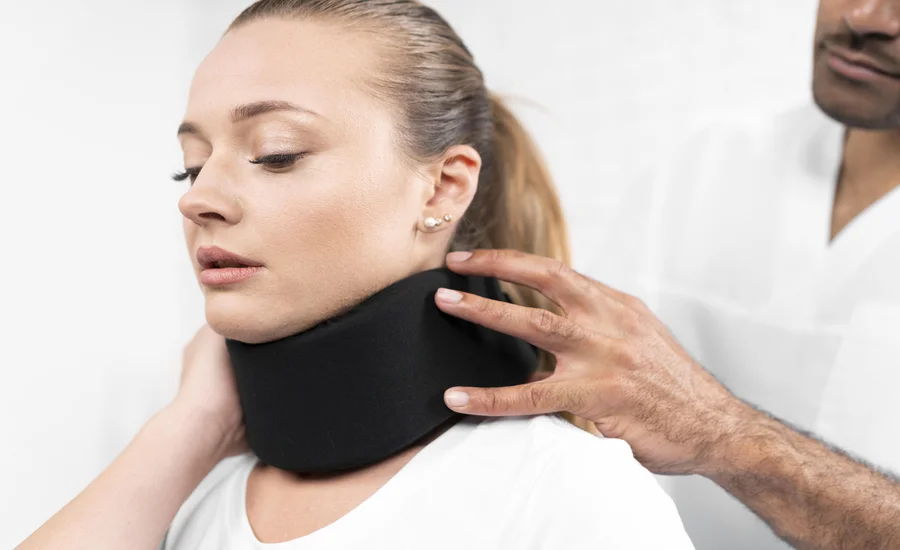A cervical collar, often called a neck brace, is a medical device used to support the neck, restrict movement, and allow healing after injuries or surgery. It is also used for people with chronic neck conditions to reduce pain and improve stability.
For years, cervical collars had a reputation for being stiff, bulky, and uncomfortable something people wanted to remove as soon as possible. But things have changed. Over the past couple of years, major improvements have been made in design, materials, and technology. Today, cervical collars are lighter, smarter, and far more comfortable than ever before.
Why Comfort and Design Matter
Wearing a cervical collar can be challenging, especially if you need to wear it for several hours a day or even weeks. When a collar is uncomfortable, patients may wear it incorrectly or remove it too soon, which can slow recovery.
A good design is not just about holding the neck in place. it should make daily life easier, not harder. Comfortable collars reduce skin irritation, make breathing and swallowing easier, and allow people to rest better at night. When patients feel at ease, they are more likely to follow their doctor’s advice, which leads to faster and safer healing.
Latest Innovations in Cervical Collar Design
Cervical collar technology has come a long way. Let’s look at the most exciting innovations shaping 2024 and 2025:
1. 3D-Printed and Custom-Fit Collars
One of the biggest breakthroughs is the use of 3D scanning and printing.
- Patients can now get collars designed to perfectly fit the shape of their neck and shoulders.
- This reduces pressure points, prevents rubbing, and makes the collar much lighter.
- Custom collars also look less bulky, which helps people feel more confident wearing them in public.
2. Smart Neck Collars
Technology is playing a big role in medical devices, and cervical collars are no exception.
- Some new collars include sensors that track neck movement and head position.
- Doctors can use this data to adjust treatment plans and make sure patients are using the collar correctly.
- In the future, smart collars may even alert patients when they move in a way that could slow healing.
3. Softer and Breathable Materials
Older collars often trapped heat and caused itching or sweating.
- Modern collars now use soft, skin-friendly materials and breathable fabrics.
- This keeps the neck cool and dry, even during long wear.
- Memory foam padding is also being used to provide support while staying gentle on the skin.
4. Adjustable and Modular Designs
One size does not fit all — and manufacturers have started to recognize that.
- Many collars now come with adjustable height, tightness, and chin support.
- Some designs have removable or interchangeable parts, so patients can switch between a more supportive setup and a lighter, softer one as they recover.
- This flexibility makes it easier to adapt to daily activities like eating, reading, or sleeping.

5. Lightweight, Slim Profiles
No one likes to feel like they’re wearing a heavy helmet around their neck.
- Newer collars use strong yet thin materials that give proper support without adding bulk.
- A lighter design means less strain on the shoulders and neck muscles.
- Patients report that slim collars make it easier to move around, sleep, and perform daily tasks.
Benefits of These New Designs
The latest cervical collar innovations are not just about style they truly improve patient recovery. Comfortable collars encourage people to wear them as prescribed, which means better compliance and faster healing. Softer materials and improved fit reduce irritation and skin problems.
Making the experience much less stressful. Because these collars are lighter and more flexible, patients can eat, talk, and perform daily tasks with greater ease. Most importantly, a well-fitted, modern collar keeps the neck in a safe position, helping it heal correctly and reducing the risk of further injury.
How to Choose the Right Cervical Collar
With so many options available, choosing the right collar can feel overwhelming. Here’s what you should look for:
- Consult Your Doctor: Your doctor or physiotherapist will recommend the right level of support based on your injury or condition.
- Check the Fit: The collar should hold your head in a neutral position without feeling too tight or loose.
- Look for Comfort Features: Soft padding, breathable materials, and lightweight construction are essential.
- Adjustability Matters: A collar with adjustable straps or height settings allows you to find the perfect fit.
- Ease of Use: Make sure it’s easy to put on and take off, especially if you’ll be using it for a long time.
Challenges That Still Exist
Even with all these advancements, there are still a few challenges to overcome. Custom-fit and 3D-printed collars can be costly, making them less accessible for some patients. In many regions, the latest designs are not widely available, which limits choice.
Designers must also maintain the right balance between comfort and proper neck support to ensure safety during recovery. Lastly, awareness remains an issue many patients and even some clinics are still unfamiliar with these newer, more comfortable options.
Real-Life Example
Imagine someone recovering from neck surgery who needs to wear a collar for six weeks. An older, bulky collar could make sleeping and eating difficult, leading to frustration and non-compliance. With a modern lightweight, breathable, and adjustable collar, the same patient can rest better, eat comfortably, and stick to their doctor’s advice leading to a smoother recovery.
FAQ
Q: Can I wear a cervical collar all day?
Only wear it for as long as your doctor recommends. Overuse can weaken neck muscles and slow recovery.
Q: Are new lightweight collars as effective as rigid ones?
Yes, many new designs use advanced materials that provide strong support while staying light and slim.
Q: How do I know if my collar is too tight?
If you feel pain, tingling, or numbness, or if it becomes hard to swallow or breathe, it might be too tight. Adjust it or consult your doctor immediately.
Q: Are adjustable collars worth the extra cost?
Yes, because they allow you to find the most comfortable fit and adjust as your recovery progresses.
Final Thoughts
Cervical collars have evolved significantly in recent years. They are no longer just stiff pieces of foam or plastic; they are carefully designed medical devices that combine support, comfort, and even technology. With 3D printing, smart sensors, breathable materials, and lightweight designs, today’s collars help patients heal faster while staying comfortable.
Stay ahead of the trends explore BusinessMusk daily.


